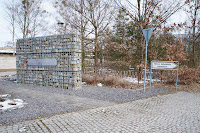JACOB JR, MY JEWISH WORLD. KONZENTRATIONSLAGER RAVENSBRÜCK. GERMANY
The Ravensbrück Women's Concentration Camp (1939-1945)
In 1939, the SS had the largest women's concentration camp in German Reich built in the Prussian village of Ravensbrück, not far from Furstenberg, a health resort that historically had belinged to Mecklenburg. The first female prisioners from Lichtenburg concentration camp were transferred to Ravensbrück in the spring of 1939. In april 1941, a men's camp was added, wich was also under the command of the women's camp's commandant, and in June 1942, the immediately adjacent Uckermark "juvenile protective custody camp" was taken in operation.
The women's concentration camp was continually expanded until 1945. The SS had more and more huts erected to house prisioners, and in the autumm of 1944, a large tent was added. Within the camp's perimeter wall, an industrial complex comprising several production facilities was established, where female prisioners were forced to carry out tasks traditionally considered women's work such as sewing, weaving or knotting.
The company Siemens & Halske had 20 workshops constructed outside the camp's perimeter, where prisioners were forced to work from the late summer of 1942. As the war progressed, over 40 satellite camps in which Ravensbrück prisioners were forced into slave labour were set up all over the German Reich.
The company Siemens & Halske had 20 workshops constructed outside the camp's perimeter, where prisioners were forced to work from the late summer of 1942. As the war progressed, over 40 satellite camps in which Ravensbrück prisioners were forced into slave labour were set up all over the German Reich.


Around 132.000 women and children, 20.000 men and 1.000 adolescent girls and young women (imprisioned in the Uckermmark "juvenile protective custody camp") were registered as Ravensbrück prisioners between 1939 and 1945. These prisioners came from over 40 nations and included Jewish people.

 Tens of thousands of them were murdered, died of hunger and disease or were killed in medical experiments. In the course of "Operation 14 f 13", prisioners considered infirm or unfit for work were selected and murdered. Along this victims of "14 f 13", a number of Jewish prisioners were taken to the Bernburg "sanatorium and nursing home" and were murdered in the facility's gas chamber. In late 1944, the SS set up a provisional gas chamber at Ravensbrück in a hut next to the crematorium, where between 5.000 and 6.000 prisioners were gassed between late January and April 1945.
Tens of thousands of them were murdered, died of hunger and disease or were killed in medical experiments. In the course of "Operation 14 f 13", prisioners considered infirm or unfit for work were selected and murdered. Along this victims of "14 f 13", a number of Jewish prisioners were taken to the Bernburg "sanatorium and nursing home" and were murdered in the facility's gas chamber. In late 1944, the SS set up a provisional gas chamber at Ravensbrück in a hut next to the crematorium, where between 5.000 and 6.000 prisioners were gassed between late January and April 1945. Shortly before the end of the war, the International, Danish and Swedish Red Cross evacuated around 7.500 prisioners to Sweden, Switzerland and France. Following and evacuation order from Himmler, Ravensbrück's comandant Fritz Suhren had the remaining 20.000 prisioners marched towars the north-west in several columns. On 30 April 1945, the Red Army liberated the camp and around 2.000 sick prisioners who had been left behind.
Shortly before the end of the war, the International, Danish and Swedish Red Cross evacuated around 7.500 prisioners to Sweden, Switzerland and France. Following and evacuation order from Himmler, Ravensbrück's comandant Fritz Suhren had the remaining 20.000 prisioners marched towars the north-west in several columns. On 30 April 1945, the Red Army liberated the camp and around 2.000 sick prisioners who had been left behind.  But for most of the women, men and chilldren imprisioned in Ravensbrück, the suffering did not end with their liberation.
But for most of the women, men and chilldren imprisioned in Ravensbrück, the suffering did not end with their liberation. Many of them died in the following weeks, months or years, and many of the survivors suffered from the consequences of their imprisonment even decades after their liberation.
Shalom! Aleichem.
Suporte Cultural: SOUL e L'Integration d'Association avec Israel et dans le Mond/Fr














Comments
Post a Comment